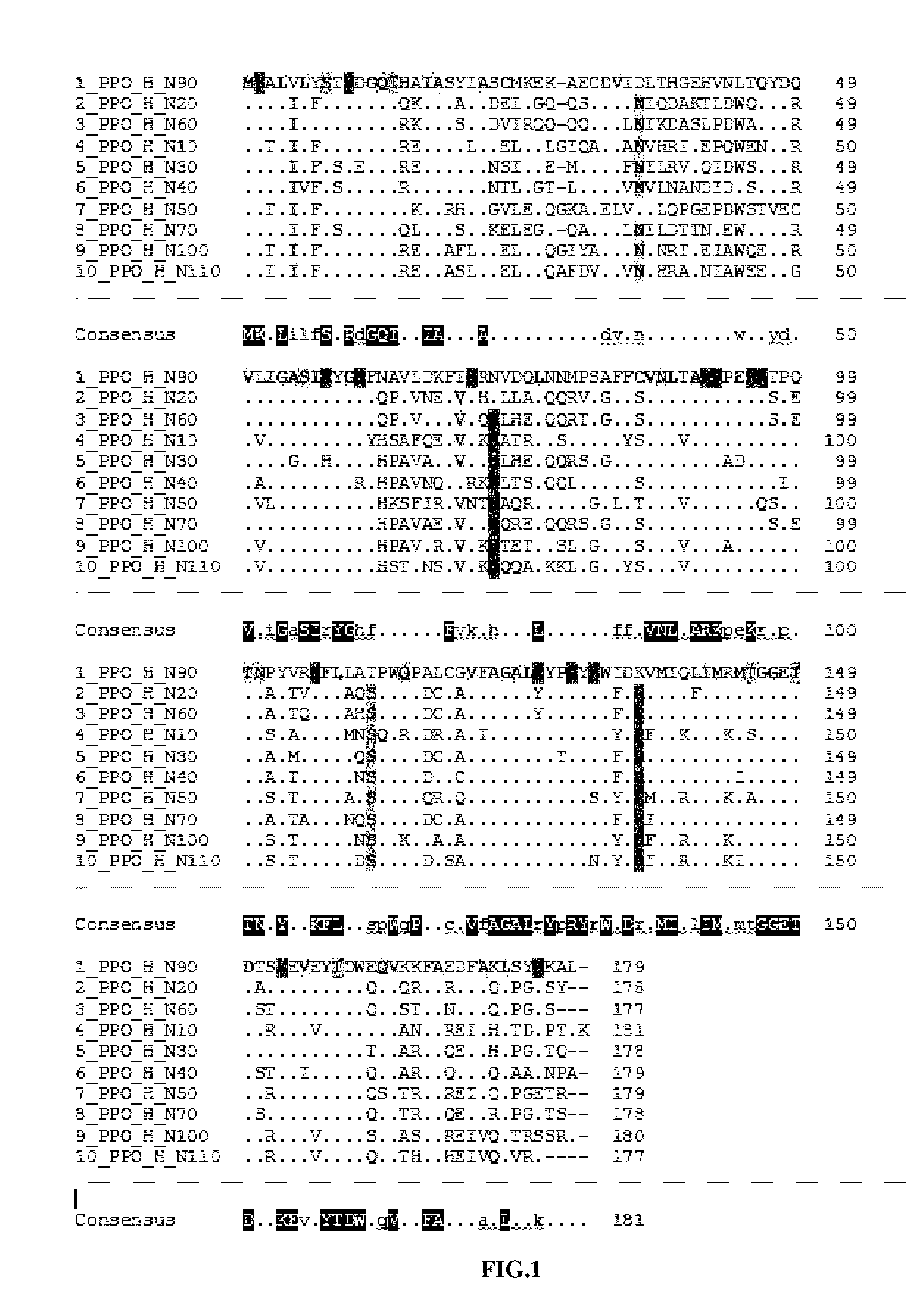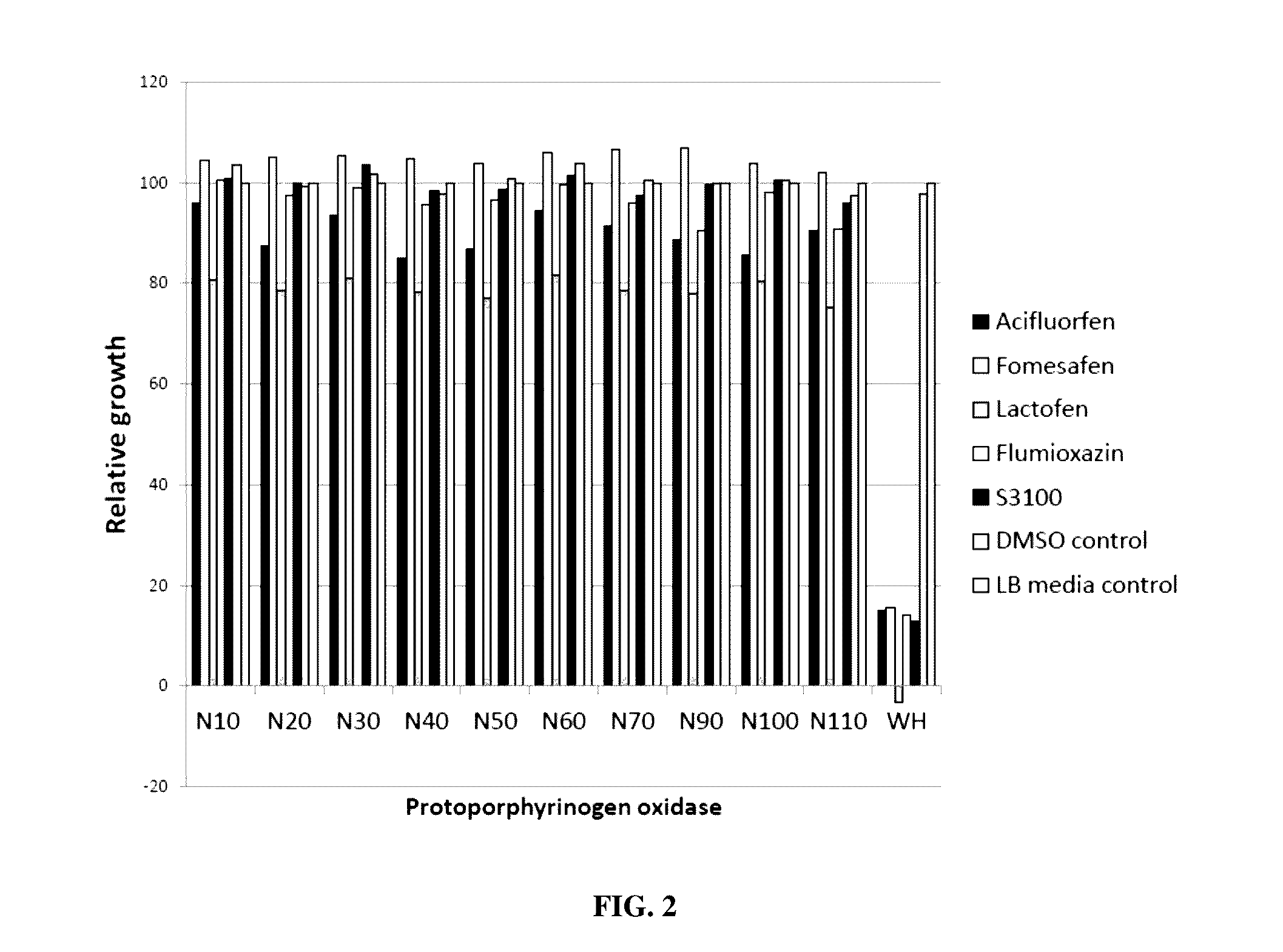Methods and compositions for herbicide tolerance in plants
a technology of herbicide tolerance and composition, applied in the field of biotechnology, can solve the problems that the transgenic crop plant comprising a recombinant ippo has yet to be commercialized, and achieve the effect of reducing the development of herbicide tolerant weeds
- Summary
- Abstract
- Description
- Claims
- Application Information
AI Technical Summary
Benefits of technology
Problems solved by technology
Method used
Image
Examples
example 1
Microbial Protoporphyrinogen Oxidase Discovery
[0073]Novel protoporphyrinogen oxidases were identified from microbial sequence databases using bioinformatic methods and a novel protoporphyrinogen oxidase bacterial screening system. The sequence ofE. coli HemG (SEQ ID NO:4) was use as a starting sequence for bioinformatic analysis of microbial sequence databases. The bioinformatic analysis identified thirty-three novel putative protoporphyrinogen oxidases of the HemG PPO family from diverse bacterial sources. The sequences encoding these putative HemG PPO enzymes were compared using phylogenetic tree mapping and found to be relatively diverse. Ten were selected for further analysis from this group of thirty-three due to their representation of individual unique clustered members on the phylogenetic tree.
[0074]The coding sequences for the ten selected HemG PPO enzymes were optimized for E. coli expression to eliminate any rare codons found in the wild-type DNA sequence. The E. coli opt...
example 2
Protoporphyrinogen Oxidase Inhibitor Insensitivity
[0077]Novel protoporphyrinogen oxidases that are tolerant to PPO herbicides were identified using an herbicide bacterial screening system. This screening system used a growth assay of the hemG knockout E. coli strain in LB liquid medium with a PPO herbicide to identify protoporphyrinogen oxidases that were not sensitive to the PPO herbicide.
[0078]The hemG knockout E. coli strain was transformed with a bacterial expression vector containing the confirmed protoporphyrinogen oxidase activity and cultured in LB liquid medium. Purified crystalline form of one of five different PPO herbicides (acifluorfen (1 mM), flumioxazin (0.5 mM), lactofen (0.5 mM), fomesafen (1 mM), and S-3100 (100 uM), representing three different PPO chemistry subclasses, was added to the medium. Recombinant proteins were expressed and the E. coli growth rates were measured. Growth curves (OD600) were measured for the different variants in the presence and absence o...
example 3
Protoporphyrinogen Oxidase (PPO) Enzyme Assay
[0080]Protoporphyrinogen oxidases were enzymatically characterized to measure each PPO enzyme's substrate binding affinity (Km) and sensitivity to the PPO herbicide (IC50). Wild-type plant PPO enzymes from waterhemp, soybean, and maize were used for comparison to the microbial HemG protoporphyrinogen oxidases (provided as SEQ ID NO: 1 through SEQ ID NO:10).
[0081]Etioplasts and chloroplasts were prepared from etiolated cotyledons (soybean, Glycine max), etiolated leaves / coleoptiles (maize, Zea mays) and unfolded apical leaves (waterhemp, Amaranthus tuberculata) generally by the procedure described by Grossmann et al., (“The Herbicide Saflufenacil (Kixor™) is a New Inhibitor of Protoporphyrinogen IX Oxidase Activity”Weed Science, 58(1):1-9 (2010)). Soybean (A3555) and maize (LH244) seeds were placed between two sheets of moist germination paper (Anchor Paper Company, Saint Paul, Minn., USA) in a beaker of water in continuous darkness for ei...
PUM
| Property | Measurement | Unit |
|---|---|---|
| Fraction | aaaaa | aaaaa |
| Molar density | aaaaa | aaaaa |
| Molar density | aaaaa | aaaaa |
Abstract
Description
Claims
Application Information
 Login to View More
Login to View More - R&D
- Intellectual Property
- Life Sciences
- Materials
- Tech Scout
- Unparalleled Data Quality
- Higher Quality Content
- 60% Fewer Hallucinations
Browse by: Latest US Patents, China's latest patents, Technical Efficacy Thesaurus, Application Domain, Technology Topic, Popular Technical Reports.
© 2025 PatSnap. All rights reserved.Legal|Privacy policy|Modern Slavery Act Transparency Statement|Sitemap|About US| Contact US: help@patsnap.com


